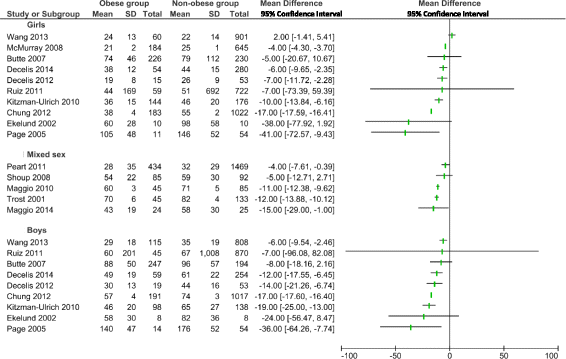Comparison of accelerometer measured levels of physical activity and sedentary time between obese and non-obese children and adolescents: a systematic review
- PMID: 29523101
- PMCID: PMC5844092
- DOI: 10.1186/s12887-018-1031-0
Comparison of accelerometer measured levels of physical activity and sedentary time between obese and non-obese children and adolescents: a systematic review
Abstract
Background: Obesity has been hypothesized to be associated with reduced moderate-to-vigorous physical activity (MVPA) and increased sedentary time (ST). It is important to assess whether, and the extent to which, levels of MVPA and ST are suboptimal among children and adolescents with obesity. The primary objective of this study was to examine accelerometer-measured time spent in MVPA and ST of children and adolescents with obesity, compared with MVPA recommendations, and with non-obese peers.
Methods: An extensive search was carried out in Medline, Cochrane library, EMBASE, SPORTDiscus, and CINAHL, from 2000 to 2015. Study selection and appraisal: studies with accelerometer-measured MVPA and/or ST (at least 3 days and 6 h/day) in free-living obese children and adolescents (0 to 19 years) were included. Study quality was assessed formally. Meta-analyses were planned for all outcomes but were precluded due to the high levels of heterogeneity across studies. Therefore, narrative syntheses were employed for all the outcomes.
Results: Out of 1503 records, 26 studies were eligible (n = 14,739 participants; n = 3523 with obesity); 6/26 studies involved children aged 0 to 9 years and 18/26 involved adolescents aged 10.1 to19 years. In the participants with obesity, the time spent in MVPA was consistently below the recommended 60 min/day and ST was generally high regardless of the participant's age and gender. Comparison with controls suggested that the time spent in MVPA was significantly lower in children and adolescents with obesity, though differences were relatively small. Levels of MVPA in the obese and non-obese were consistently below recommendations. There were no marked differences in ST between obese and non-obese peers.
Conclusions: MVPA in children and adolescents with obesity tends to be well below international recommendations. Substantial effort is likely to be required to achieve the recommended levels of MVPA among obese individuals in obesity treatment interventions. This systematic review has been registered on PROSPERO (International Database of Prospective Register Systematic Reviews; registration number CRD42015026882).
Conflict of interest statement
Ethics approval and consent to participate
Not applicable.
Consent for publication
Not applicable.
Competing interests
Statement for all authors: there is no potential Conflict of Interest to disclose and there are no financial relationships relevant to this article to disclose. The authors declare that they have no competing interests.
Publisher’s Note
Springer Nature remains neutral with regard to jurisdictional claims in published maps and institutional affiliations.
Figures



Similar articles
-
Accelerometer measured levels of moderate-to-vigorous intensity physical activity and sedentary time in children and adolescents with chronic disease: A systematic review and meta-analysis.PLoS One. 2017 Jun 22;12(6):e0179429. doi: 10.1371/journal.pone.0179429. eCollection 2017. PLoS One. 2017. PMID: 28640907 Free PMC article.
-
Interventions for promoting habitual exercise in people living with and beyond cancer.Cochrane Database Syst Rev. 2018 Sep 19;9(9):CD010192. doi: 10.1002/14651858.CD010192.pub3. Cochrane Database Syst Rev. 2018. PMID: 30229557 Free PMC article.
-
School-based physical activity programs for promoting physical activity and fitness in children and adolescents aged 6 to 18.Cochrane Database Syst Rev. 2021 Sep 23;9(9):CD007651. doi: 10.1002/14651858.CD007651.pub3. Cochrane Database Syst Rev. 2021. PMID: 34555181 Free PMC article.
-
Physical activity, diet and other behavioural interventions for improving cognition and school achievement in children and adolescents with obesity or overweight.Cochrane Database Syst Rev. 2018 Mar 2;3(3):CD009728. doi: 10.1002/14651858.CD009728.pub4. Cochrane Database Syst Rev. 2018. PMID: 29499084 Free PMC article.
-
Physical activity, diet and other behavioural interventions for improving cognition and school achievement in children and adolescents with obesity or overweight.Cochrane Database Syst Rev. 2018 Jan 29;1(1):CD009728. doi: 10.1002/14651858.CD009728.pub3. Cochrane Database Syst Rev. 2018. Update in: Cochrane Database Syst Rev. 2018 Mar 02;3:CD009728. doi: 10.1002/14651858.CD009728.pub4. PMID: 29376563 Free PMC article. Updated.
Cited by
-
Body image and health-related behaviors among fitspirit participants.BMC Public Health. 2022 Sep 17;22(1):1764. doi: 10.1186/s12889-022-14131-7. BMC Public Health. 2022. PMID: 36115946 Free PMC article.
-
Considerations in using heart rate-based physical activity estimates from consumer wearables in individuals with varying weight status.Int J Behav Nutr Phys Act. 2025 Jul 28;22(1):106. doi: 10.1186/s12966-025-01801-z. Int J Behav Nutr Phys Act. 2025. PMID: 40721804 Free PMC article.
-
Prevalence and socio-demographic correlates of accelerometer measured physical activity levels of school-going children in Kampala city, Uganda.PLoS One. 2020 Jul 9;15(7):e0235211. doi: 10.1371/journal.pone.0235211. eCollection 2020. PLoS One. 2020. PMID: 32645010 Free PMC article.
-
Intervention for Children with Obesity and Overweight and Motor Delays from Low-Income Families: Fostering Engagement, Motor Development, Self-Perceptions, and Playtime.Int J Environ Res Public Health. 2022 Feb 22;19(5):2545. doi: 10.3390/ijerph19052545. Int J Environ Res Public Health. 2022. PMID: 35270238 Free PMC article. Clinical Trial.
-
Effects of a Physical Literacy Breaks (PLBreaks) Program on Physical Literacy and Body Composition in Portuguese Schoolchildren: A Study Protocol.Biology (Basel). 2022 Jun 13;11(6):910. doi: 10.3390/biology11060910. Biology (Basel). 2022. PMID: 35741431 Free PMC article.
References
-
- Dietz WH. Health consequences of obesity in youth: childhood predictors of adult disease. Pediatrics. 1998;101(3):518–525. - PubMed
Publication types
MeSH terms
Grants and funding
LinkOut - more resources
Full Text Sources
Other Literature Sources
Medical

